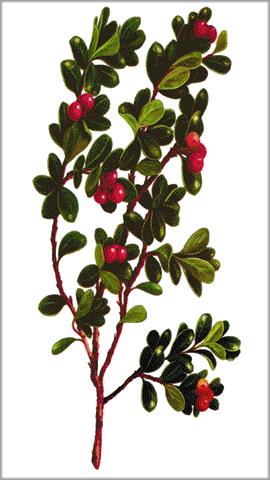> Indexe of medicinal plants (B) > Bearberry
Bearberry (Arctostaphylos uva-ursii)

Arbustillo that grows in areas of the Pyrenees, hills and mountains, tends to creep along the ground and each stem produces its own roots, which in case of separation of the parent stem allowed to continue to survive and develop with complete normality.
We can also sometimes find it hanging from a height.
It has branches that develop twisting on themselves, creating irregular shapes; of these branches the leaves are born with a venation on the underside that crosses, like a grid. Moreover, according to growing area, there may be differences in the shape and size of them.
Decoction. With 30 grams of leaves on a liter of water, letting it boil for ten minutes, is taken as the infusion.
Maceration. Suitable for people sensitive to the earlier types. Allow to marinate 25 grams of leaves per liter of water for a day, is filtered and the resulting liquid is taken warm.
HABITAT: Alps and Pyrenees
FLOWERING: March, April, May and June
PART USED: Sheets
CASTILIAN: Manzanilla de pastor
CATALAN: Raïm d´óssa
BASQUE: Otso-mats
FLOWERING
It blooms from March until late June, resulting in flowers that are grouped together forming a sort of clusters of up to ten units, which leave from the axils of the leaves, usually those from last year. The fruit is then formed reddish, tasteless and floury tasting. The best time to proceed with the collection of leaves is the summer, it can be performed equally in any other time. Younger leaves have a bitter taste. Being a fairly common plant is not necessary growing process to get their leaves, as can be collected perfectly using plants that grow spontaneously in the field.APPLICATIONS
It is a plant rich in tannins, gallic containing up to 10% of its weight, which gives it astringent properties, together with allantoin which contains, make it ideal for difficult cases of scarring, open wounds and infected . Contains arbutósido by 5%, which provides antimicrobial properties, mainly against germs that are found in the urinary tract, used in cases of urinary tract infections because the arbutósido undergoes a transformation in the body (specifically in the intestine) releasing hydroquinone, which in turn is eliminated by the kidneys, thus achieves the desired effect antiinfective. Therefore used in cases of nephritis, cystitis, prostatitis and urinary stones. The presence of tannins suggest a moderate employment because it can cause gastric upset boxes, is to decrease the dose in susceptible individuals.ADMINISTRATION
Infusion. Add 25 grams of leaves to one liter of boiled water, which can be administered as an infusion, take all the liquid thus obtained spread over the day.Decoction. With 30 grams of leaves on a liter of water, letting it boil for ten minutes, is taken as the infusion.
Maceration. Suitable for people sensitive to the earlier types. Allow to marinate 25 grams of leaves per liter of water for a day, is filtered and the resulting liquid is taken warm.
SUMMARY
FAMILY: EricaceaeHABITAT: Alps and Pyrenees
FLOWERING: March, April, May and June
PART USED: Sheets
CASTILIAN: Manzanilla de pastor
CATALAN: Raïm d´óssa
BASQUE: Otso-mats
USES
Astringency, Moderate urinary antiseptic, Healing Light.
Important: The use of information on medicinal plants, without the minimum knowledge in dosage and descriptions can cause problems or side effects. You should always talk to a doctor, pharmacist or qualified personnel before taking herbs or medicinal plants. Take the texts and information such as single orientation for subsequent verification contrast and medical professionals. World Topic assumes no liability in connection with the material on the web.
Collaborate · Recommend · Contact · Terms · Privacy Acreditación:
© Mundo Tema Medicinal Plants (www.mtplantas.com)


